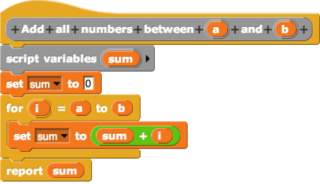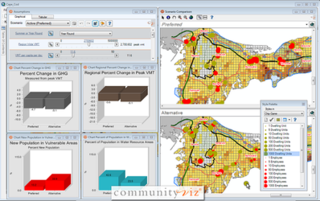Autodesk, Inc. is an American multinational software corporation that provides software products and services for the architecture, engineering, construction, manufacturing, media, education, and entertainment industries. Autodesk is headquartered in San Francisco, California, and has offices worldwide. Its U.S. offices are located in the states of California, Oregon, Colorado, Texas, Michigan, New Hampshire and Massachusetts. Its Canada offices are located in the provinces of Ontario, Quebec, and Alberta.
Autodesk 3ds Max, formerly 3D Studio and 3D Studio Max, is a professional 3D computer graphics program for making 3D animations, models, games and images. It is developed and produced by Autodesk Media and Entertainment. It has modeling capabilities and a flexible plugin architecture and must be used on the Microsoft Windows platform. It is frequently used by video game developers, many TV commercial studios, and architectural visualization studios. It is also used for movie effects and movie pre-visualization. 3ds Max features shaders, dynamic simulation, particle systems, radiosity, normal map creation and rendering, global illumination, a customizable user interface, and its own scripting language.

Gmax is an application based on Autodesk's 3ds Max application used by professional computer graphics artists. 3ds Max is a comprehensive modeling, animation and rendering package with some secondary post-production and compositing features. Gmax is much more limited due to its singular intended use—game content creation. Infrequently used tools and features, or the ones completely unrelated to creating 3D game models, were removed, leaving the core modeling, texturing, and basic animation rigging and keyframing capabilities. In 2005, the promotional freeware software was discontinued after version 1.2.

In computing, a visual programming language, also known as diagrammatic programming, graphical programming or block coding, is a programming language that lets users create programs by manipulating program elements graphically rather than by specifying them textually. A VPL allows programming with visual expressions, spatial arrangements of text and graphic symbols, used either as elements of syntax or secondary notation. For example, many VPLs are based on the idea of "boxes and arrows", where boxes or other screen objects are treated as entities, connected by arrows, lines or arcs which represent relations. VPLs are generally the basis of Low-code development platforms.

OpenSceneGraph is an open-source 3D graphics application programming interface, used by application developers in fields such as visual simulation, computer games, virtual reality, scientific visualization and modeling.
COLLADA is an interchange file format for interactive 3D applications. It is managed by the nonprofit technology consortium, the Khronos Group, and has been adopted by ISO as a publicly available specification, ISO/PAS 17506.

The Common Image Generator Interface (CIGI), is an on-the-wire data protocol that allows communication between an Image Generator and its host simulation. The interface is designed to promote a standard way for a host device to communicate with an image generator (IG) within the industry.
SpeedTree is a group of vegetation programming and modeling software products developed and sold by Interactive Data Visualization, Inc. (IDV) that generates virtual foliage for animations, architecture and in real time for video games and demanding real time simulations.

Rhinoceros is a commercial 3D computer graphics and computer-aided design (CAD) application software that was developed by TLM, Inc, dba Robert McNeel & Associates, an American, privately held, and employee-owned company that was founded in 1978. Rhinoceros geometry is based on the NURBS mathematical model, which focuses on producing mathematically precise representation of curves and freeform surfaces in computer graphics.
Navisworks is a 3D design review package for Microsoft Windows.

CommunityViz is the name of a group of extensions to ArcGIS Geographic Information System software. CommunityViz is an analysis tool used for, among other applications, urban planning, land use planning, geodesign, transportation planning and resource management applications. It also provides options for 3D visualization in the Scenario 3D and Scenario 360 plugins. CommunityViz also allows users to export and view their work in ArcGIS Online, Google Earth and other KML/KMZ viewers such as ArcGIS Explorer. The software was originally produced by the Orton Family Foundation and in 2005 was handed off to Placeways LLC. In 2017, the software was purchased by City Explained, Inc. where its development continues.

3D computer graphics, sometimes called CGI, 3-D-CGI or three-dimensional computer graphics, are graphics that use a three-dimensional representation of geometric data that is stored in the computer for the purposes of performing calculations and rendering digital images, usually 2D images but sometimes 3D images. The resulting images may be stored for viewing later or displayed in real time.
AC3D is a 3D design program which has been available since 1994. The software is used by designers for modeling 3D graphics for games and simulations - most notably it is used by the scenery creators at Laminar Research on the X-Plane (simulator). The .ac format has also been used in FlightGear for scenery objects and aircraft models.
3D computer graphics software refers to packages used to create 3D computer-generated imagery.

Art of Illusion is a free software, and open source software package for making 3D graphics.






